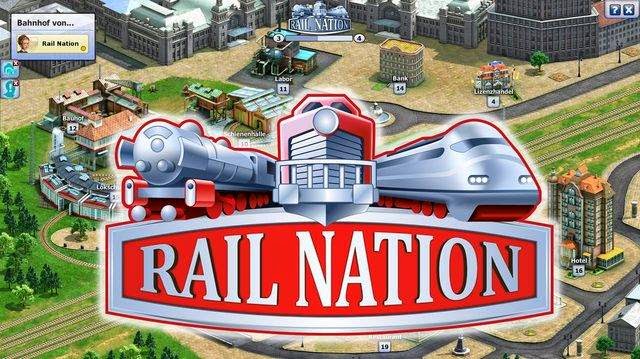Rail Nation is a captivating browser-based strategy game that combines the allure of trains with deep economic and competitive gameplay. Developed by Bright Future and published by Travian Games GmbH in 2013, Rail Nation has garnered a dedicated following of players who enjoy its blend of city-building, resource management, and competition. The game challenges players to build and manage a successful railway empire, transporting goods, expanding their networks, and competing against others in a persistent online world.
This article takes an in-depth look at Rail Nation, exploring its gameplay mechanics, strategic elements, and what makes it an enduring favorite among fans of simulation and strategy games.
The Basics of Rail Nation
Rail Nation is set in a world where trains are the primary means of transportation. Players start as the owner of a small train company and must develop it into a vast railway empire by transporting goods, expanding their network, and upgrading their trains. The game spans six eras, each representing a different historical period of railway development, from the steam engines of the 19th century to the high-speed trains of the modern era.
The game is played in rounds, typically lasting between 12 to 14 weeks, after which the world resets, and players can start a new game. This structure allows for a fresh experience each time, with different strategies and outcomes.
Core Gameplay Mechanics
1. Train and Engine Management
At the heart of Rail Nation is the management of your trains and engines. Players start with basic steam engines and gradually unlock more advanced trains as they progress through the eras. Each engine has specific attributes, such as speed, reliability, and cargo capacity, which affect its performance and profitability.
Players must carefully choose which trains to purchase and upgrade, balancing the cost of new engines with the need to improve their network. Upgrading trains can significantly boost efficiency, allowing for faster and more profitable deliveries. Players can also customize their trains with various upgrades, such as better engines, enhanced cargo capacity, or improved reliability.
2. Transporting Goods
Transporting goods is the primary way to earn money in Rail Nation. The game world is populated with cities and industries that produce various goods, from raw materials like coal and iron to finished products like food and clothing. Players must connect these industries to their railway network and transport goods to cities where they are in demand.
Successfully managing the flow of goods is key to maximizing profits. Players must consider factors such as delivery times, the demand for goods in different cities, and the competition from other players. As the game progresses, the complexity increases, with new goods becoming available and cities growing, leading to changing demands.
3. City Development and Cooperation
Rail Nation features a cooperative element where players can work together to develop cities. As players deliver goods to a city, its population grows, and new industries and upgrades become available. Cities are central to the game’s competitive aspect, as players can join forces to ensure their city becomes one of the most prosperous in the game world.
Players can join associations, which are essentially guilds or alliances, to collaborate with others. Associations play a significant role in the game, as they allow players to pool resources, coordinate strategies, and compete in regional and global competitions. Working with others in an association can provide significant advantages, especially in the endgame.
4. Research and Upgrades
Rail Nation features a robust research system that allows players to unlock new technologies and upgrades as they progress through the eras. The research tree includes various paths, such as improving train speed, increasing cargo capacity, and enhancing reliability. Players must decide which technologies to prioritize based on their strategy and the current needs of their network.
Upgrades are crucial for staying competitive, as they allow players to increase the efficiency and profitability of their trains. In addition to researching new technologies, players can invest in upgrading their existing trains and infrastructure, ensuring they remain competitive as the game progresses.
5. The Endgame: The Race for Prestige
Prestige is the primary measure of success in Rail Nation. Players earn prestige points by delivering goods, completing achievements, and contributing to city development. The player or association with the most prestige at the end of the game round is declared the winner.
The endgame is particularly intense, as players compete to deliver the most goods to their chosen city during the final phase, known as the Endgame. The Endgame focuses on delivering essential goods to cities, with the goal of becoming the most prestigious city in the game world. This phase requires careful planning, coordination with other players, and efficient management of resources.
The Strategic Depth of Rail Nation
Rail Nation’s appeal lies in its strategic depth and the many layers of gameplay that challenge players to think critically and plan ahead. Success in the game requires balancing multiple factors, from managing your railway network to cooperating with other players.
1. Economic Strategy
Rail Nation’s economic gameplay is both challenging and rewarding. Players must constantly adapt to changing market conditions, such as fluctuating demand for goods and competition from other players. Efficiently managing resources, optimizing delivery routes, and making smart investments in trains and infrastructure are all key to maximizing profits.
2. Competitive Play
Competition is at the core of Rail Nation. Players are constantly vying for dominance, whether it’s in the race to deliver goods, the struggle to control cities, or the battle for prestige. The game’s competitive elements are heightened by the presence of other players, who can cooperate, compete, or sabotage each other’s efforts.
The endgame, in particular, is a test of strategic acumen and coordination, as players must work together with their association to achieve victory. The competitive nature of the game keeps players engaged and motivated, as there’s always another challenge or rival to overcome.
3. Cooperative Elements
While Rail Nation is highly competitive, it also emphasizes cooperation. Joining an association and working with other players can significantly enhance your chances of success. Associations allow players to share resources, coordinate strategies, and achieve common goals.
The cooperative aspects of the game add a social dimension that enhances the overall experience. Building relationships with other players, negotiating alliances, and working together to develop cities or win competitions are all integral parts of the game.
The Visual and Thematic Appeal
Rail Nation’s visual design and thematic elements contribute to its charm. The game features detailed and colorful graphics that bring the world of trains to life. The train models are well-designed and historically accurate, adding a layer of authenticity to the experience.
The game’s theme of railway expansion and industrialization is appealing to fans of history and simulation games. Rail Nation successfully captures the excitement and challenges of managing a railway empire, making it a hit with players who enjoy both strategy and simulation genres.
Monetization: Free-to-Play with Premium Options
Rail Nation is free-to-play, but it includes premium options that allow players to purchase in-game currency and other benefits. Players can buy Gold, the game’s premium currency, which can be used to speed up research, purchase special trains, or acquire other advantages.
While premium purchases can provide a competitive edge, Rail Nation is designed to be balanced for both paying and non-paying players. The game’s monetization model allows players to enjoy the full experience without spending money, though those who choose to invest in premium options may find it easier to progress and compete.
Why Rail Nation Remains Popular
Rail Nation has remained popular for several reasons:
1. Deep and Engaging Gameplay
The game’s combination of economic strategy, city-building, and competition provides a deep and engaging experience that keeps players coming back. The six eras offer a sense of progression and variety, ensuring that each round of the game feels fresh and exciting.
2. Social and Competitive Aspects
The cooperative and competitive elements of Rail Nation are a major draw for players. The ability to join associations, compete in regional and global events, and work with or against other players adds a dynamic and social aspect that enhances the overall experience.
3. Regular Updates and Events
The developers regularly update Rail Nation with new features, events, and content, keeping the game fresh and relevant. These updates often include special scenarios, new trains, and other additions that provide new challenges and opportunities for players.
4. Accessibility
As a browser-based game, Rail Nation is highly accessible. It can be played on a wide range of devices without the need for downloads or installations. This accessibility makes it easy for new players to join and for veteran players to continue enjoying the game across different platforms.
Conclusion
Rail Nation is a standout title in the world of online strategy games. Its blend of economic management, city-building, and competitive gameplay offers a rich and rewarding experience that appeals to a wide range of players. Whether you’re a train enthusiast, a fan of strategy games, or simply someone looking for a deep and engaging online experience, Rail Nation has something to offer.
The game’s enduring popularity is a testament to its well-crafted mechanics, engaging gameplay, and the strong community it has fostered. With its regular updates, vibrant player base, and the endless possibilities for strategy and competition, Rail Nation continues to be a must-play game for anyone interested in building and managing a railway empire.







